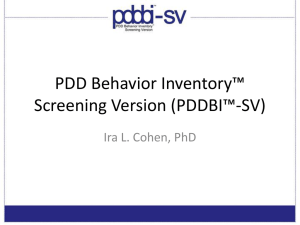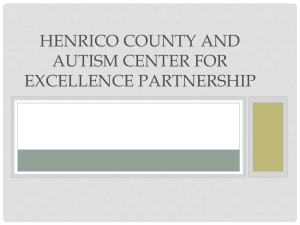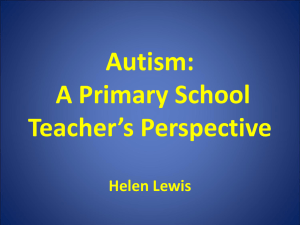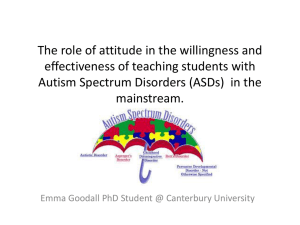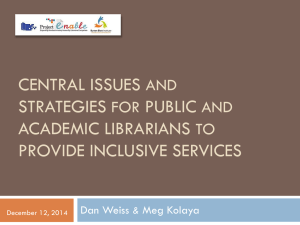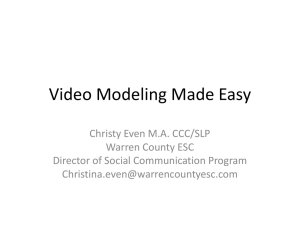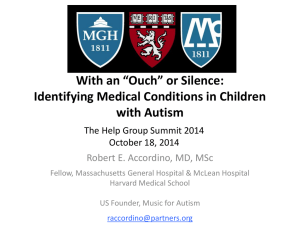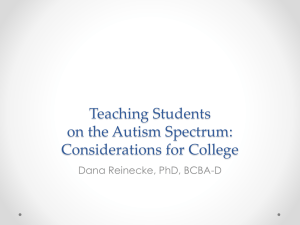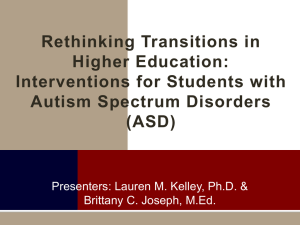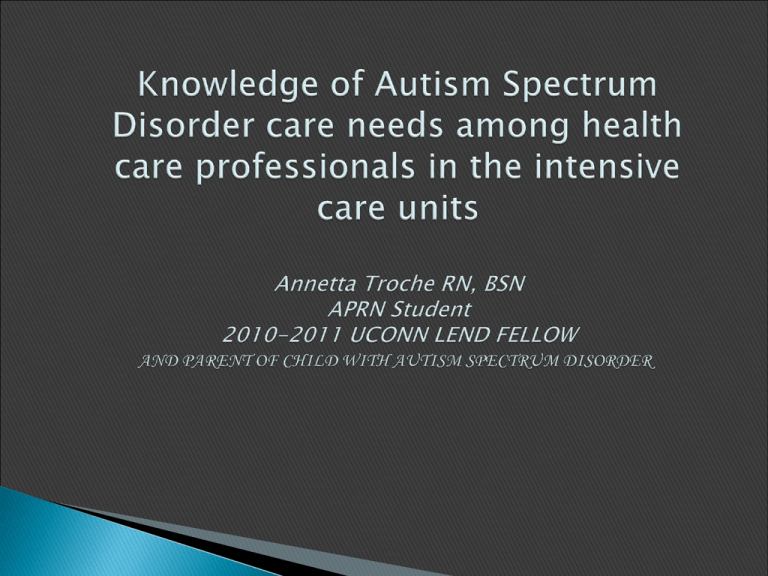
In 2006, one in every 110 children was classified
as having an autism spectrum disorder (ASD).
The CDC claims that the incidence of ASD is
rising.
People with developmental disabilities, including
ASD, are living longer.
More adults with developmental disabilities,
including ASD, are being seen in the hospital.
The hospital environment can be an
overwhelming place for those with sensory
issues.
In the Intensive Care Unit(s) (ICU), these issues
are magnified.
ICUs are not prepared to meet the unique needs
of people with ASD.
Research is needed to determine what the current
knowledge about ASD care needs is among
health care professionals.
Sensory issues
From the literature it is evident that people with
ASD have unique needs and require
individualized treatment plans to address those
needs.
It is also evident that parental or caregiver
involvement in those treatment plans is essential.
The involvement of parents in the care of people
with ASD is in keeping with the current
movement in health care toward family-centered
care.
Among other things, family-centered care has
been shown in literature to improve family
outcomes, increase satisfaction among patients
and families, increase professional satisfaction,
and lead to more effective use of health care
resources.
One of the principles of family-centered care is
“ensuring flexibility in organizational policies,
procedures, and provider practices so services
can be tailored to the needs, beliefs, and cultural
values of each child and family” (CHC, 2003).
The goal is to conduct a need
assessment of the gaps in
knowledge about ASD care needs
among professionals in one
hospital’s ICUs in Connecticut.
“Gap analysis directly informs the development of learning
objectives for educational activities” (Greene, L. & Prostko,
C., 2008).
Invite all health professionals working
in the ICUs, including physicians,
physician assistants, nurse
practitioners, respiratory therapists,
social workers, speech, physical and
occupational therapists, to participate
in a survey about their knowledge of
ASD care needs, including familycentered care.
The first section of the survey was meant to
elicit the professionals’:
frequency of contact with people with an
Autism Spectrum Disorder (ASD),
type of relationship with a person with an
ASD,
frequency that they cared for someone in the
ICU with an ASD, and
their feelings on whether their were necessary
policies and procedures in place to care for
people with an ASD.
The second section was meant to ascertain
whether the professionals:
felt their training had prepared them to care
for people with an ASD,
felt it was important in their profession to
know how to care for a person with an ASD,
felt comfortable caring for a person with an
ASD, and finally,
felt parents and caregivers should always be
welcome in the ICU and/or during change of
shifts and during treatments.
A comments section allowed the
respondents to provide additional
information about caring for people with
an ASD in the ICU.
Each person was also asked to report
their age, sex, race, specific profession,
and number of years in that profession.
Discipline
ICU staff
Responses
Attending
resident physicians
18
9
3
3
PAs
NPs
13
25
2
5
Nurses
227
35
Social workers
5
2
Respiratory therapists
71
11
PT
OT
speech therapist
23
5
2
4
NP=nurse practitioner
PA= physician’s
assistant
1 respondent skipped
the demographics
section
Number of surveys sent out = 391; number of responses = 73
Response rate = 18.7%
At least:
80% of respondents were female (2
people skipped this question).
48.6% of the respondents were nurses (1
person skipped this question).
50% of respondents had worked in their
current profession for over 10 years (1
person skipped this question).
Number of respondents
number of respondents
Number of respondents
number of respondents
76.7%
16.4%
6.8%
number of respondents
30
25
20
Strongly disagree
Moderately disagree
15
Somewhat disagree
Somewhat agree
10
Moderately agree
Strongly agree
5
0
My training has prepared me to care
In my profession, it is important for me to
for a person with an ASD
know how to care for a person with ASD
number of respondents
35
30
25
20
Strongly disagree
Moderately disagree
15
Somewhat disagree
10
Somewhat agree
Moderately agree
5
Strongly agree
0
I know enough about ASDs to feel
I think that caregivers of people with ASDs
comfortable taking care of a patient with it.
who are in the ICU should always be
welcome to be with the patient and not be
seen as visitors.
number of respondents
40
35
30
25
Strongly disagree
20
Moderately disagree
Somewhat disagree
15
Somewhat agree
10
Moderately agree
Strongly agree
5
0
I think parents or caregivers of people with
I think parents and caregivers of people
an ASDs should be allowed to remain with
with ASD should be present during
the patient during nurse change of shft, in
treatments in accordance with patient
accordance with patient preference.
preference.
…”help staff familiarize with patient population
and provide evidence based practice.”
…”the noise level and lack of education about
this population is paramount…”
“… an in service on autism would be helpful.”
…”other than in school never had any info on
patient with autism.”
…”tips on communication”…
“…more education for staff about the disorder
and associated special needs would be most
helpful.”
“Like any diagnosis that one is unfamiliar with
should necessitate information on how to best
care for patient with”…
“There are Healthstream presentations on several
other types of patients with unique needs. We
should have one on ASD as a minimum…”
“each case should be looked at individually…”
…“changes in visitation policies.”
…“information about specialized strategies to
provide care in the best manner to maintain
independence and pt-centered care.”
“Policies that allow continuity of pre-hospital
care.”
“early psychiatry consult more to assist the
staff in education for appropriate and
expected interactions.”
“dedicated speech/PT/OT specialists”
“…Psych consults are an important part of
our team and will utilize their skills if certain
behaviors are a challenge for the staff.”
“this comes up infrequently…a large
population of our patients are sedated,
unconscious or confused.”
“NONE!! DO NOT confuse policy and
procedures with PROPER TRAINING!!
Autism spectrum disorder is the psych.
flavor-of-the-decade. There is not a
large older population because the
diagnosis was not in vogue decades
ago!...”
The small number of people who responded
The fact that all the participants were from one
hospital
The possible deficiencies of the survey to elicit
desired information about health professionals’
current knowledge about ASD and familycentered care
Giving the participants so much information in
the “background” piece of the informed assent
section probably steered some people’s thinking
as it gave them ideas on some of the issues
people with ASD might have in the ICUs.
The results are an important addition to literature
as they provide some information about the
knowledge of ASD care needs (or lack of) among
professionals in the ICU.
From this need assessment it is unclear whether or
not training among ICU professionals about the
care needs of people with ASD is important at this
time. Although people want to be prepared to care
for people with ASD, they are probably not seeing
enough people with ASD in the ICUs to justify the
cost of providing training for all the staff in the
ICUs. However, it would be most reasonable to
create some sort of informational pamphlet that
staff could access at their will.
This need assessment may show very
different results in years to come.
Hospitals that wish to be leaders in
the future should begin to plan how
they will prepare their staff to best
care for people with an ASD and their
families. Family-centered care is key
and will not only benefit people with
ASD and their families, but all people.
Allison, K.P. & Smith, G. (1998). Burn management in a patient with autism.
BURNS 24, 484-486.
Aulagnier, M., Verger, P., Ravaud, J.F., Souville, M., Lussault, P.Y., Garnier, J.P.,
and Paraponaris, A. (2005). General practitioners’ attitudes towards patients with
disabilities: the need for training and support. Disabil Rehabil. Nov. 30; 27(22): 1343-52.
Bakare, M.O., Ebigbo, P.O., Agomoh, A.O. & Menkiti, N.C. (2008). Knowledge about
childhood autism among health workers- (KCHW) questionnaire description, reliability and internal consistency. Clinical
Practice and Epidemiology in Mental Health 4 (17).
Barraban-Gil, K., Rapin, I., Tucman, R., Shinnar, S. (1996). Longitudinal examination of
the behavioural, language, and social changes in a population of adolescents and young adults with autistic disorder.
Paediatric Neurology, 15 (3), 217-223.
Beard-Pfeuffer, M. (2008). Understanding the world of children with autism. RN, February, 40-46.
Centers for Disease Control and Prevention (2009). Autism information center.
Prevalence of ASDs. Retrieved December 20, 2010, from http://www.cdc.gov/mmwr/preview/mmwrhtml/ss5810a1.htm
Committee on Hospital Care (CHC); Policy Statement (2003). Family-Centered Care and the Pediatrician’s Role. Pediatrics,
112(3): 691-696.
Dell, D.D., Feleccia, M., Hicks, L., Longstreth-Papsun, E., Politsky, S. & Trommer, C.
(2008). Care of Patients With Autism Spectrum Disorder Undergoing Surgery for Cancer. Oncology Nursing Forum 35(2),
177-182.
Greene, L. & Prostko, C., (2008). Educational Needs Assessment, Activity Development, and Outcomes Assessment at
PRIME: Applications of Established Conceptual Frameworks and Principles of Adult Learning. Retrieved December 24, 2010
from: http://primeinc.org/scienceofcme/adult_learning_principles
Institute for Family-Centered Care-Tools for change. Available at www.familycenteredcare.org/tools/index.html.
Institute of Medicine (IOM). (1999). To Err Is Human: Building a Safer Health System,
Washington, DC: National Academics Press
Kuzin, J.K., Yborra, J.G., Taylor, M.D., Chang, A.C., Altman, C.A., Whitney, G.M., and
Mott, A.R. (2007). Family-member presence during interventions in the intensive care unit: perceptions of
pediatric cardiac intensive care providers. Pediatrics, Oct., 120(4):e895-901.
KW, Au & DW, Man (2006). Attitudes toward people with disabilities: a comparison between health
professionals and students. Int. J Rehahabil Res. Jun. 29(2): 155-60.
National Autistic Society. (1990). Parent and professional partnership in caring for adults with autism.
Retrieved December 20, 2010, from http://www.nas.org.uk/nas/jsp/polopoly.jsp?d=364&a=2181
Nelson, D. & Amplo, K. (2009). Care of the Autistic Patient in the Perioperative Area.
AORN Journal 89(2), 391-397.
O’Malley, P.J., Brown, K., Krug, S.E., and the Committee on Pediatric Emergency Medicine. (2008). Patient- and
Family- Centered Care of Children in the Emergency Department. Pediatrics, 122(2): e511-521.
O’Regan, P. & Drummond, E. (2008). Cancer information needs of people with Intellectual disability: a review of
the literature. Eur J Oncol Nurs. Apr, 12(2): 142-7
Pajares, F. The Elements of a Proposal. Retrieved December 24, 2010 from:
http://www.des.emory.edu/mfp/proposal.html
Silver, I.L. & Leslie, K. (2009). Faculty development for continuing interprofessional education and collaborative
practice. J Contin. Educ. Health Prof. Summer, 29(3):172-7.
Stevens, A. & Gillam, S. (1998). Needs assessment: from theory to practice. BMJ, May, 316:1448
Tervo, R.C. & Palmer, G. (2004). Health professional student attitudes towards people with disabilities. Clin.
Rehabil., Aug.,18(8): 908-915
Tracy , J. & Iacono, T. (2008). People with developmental disabilities teaching medical students Does it make a
difference? Journal of Intellectual and Developmental Disability, 33(4), 345-348.
Van der Walt, J.H. & Moran, C. (2001). An audit of perioperative management of autistic children. Paediatric
Anaesthesia, 11(4), 401-408.

